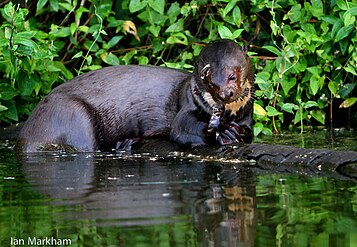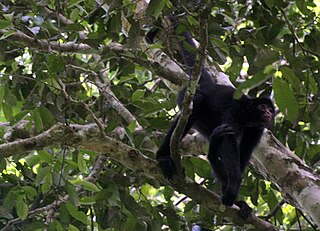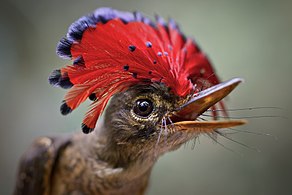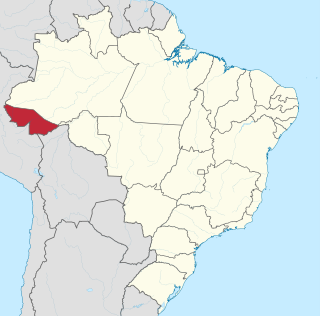
Acre ( ) is a state located in the west of the North Region of Brazil and the Amazonia Legal. Located in the westernmost part of the country, at a two-hour time difference from Brasília, Acre is bordered clockwise by the Brazilian states of Amazonas and Rondônia to the north and east, along with an international border with the Bolivian department of Pando to the southeast, and the Peruvian regions of Madre de Dios, Ucayali and Loreto to the south and west. Its capital and largest city is Rio Branco. Other important places include Cruzeiro do Sul, Sena Madureira, Tarauacá and Feijó. The state, which has 0.42% of the Brazilian population, generates 0.2% of the Brazilian GDP.

Madre de Dios is a department and region in southeastern Peru, bordering Brazil, Bolivia and the Peruvian departments of Puno, Cusco and Ucayali, in the Amazon Basin. Its capital is the city of Puerto Maldonado. It is also the third largest department in Peru, after Ucayali and Loreto. However, it is also the least densely populated department in Peru, as well as its least populous department. It has one of the lowest poverty rates in Peru.

The Madre de Dios River is a river shared by Bolivia and Peru which is homonymous to the Peruvian region it runs through. On Bolivian territory, it receives the Beni River, close to the town of Riberalta, which later joins with the Mamore River to become the Madeira River after the confluence. The Madeira is a tributary to the Amazon River.

The Manú is a river in southeastern Peru. It runs down the eastern slopes of the Andes Mountains into the Amazon Basin. It runs through what is now protected as the Manú National Park, a vast Biosphere Reserve, home to arguably the highest concentration of biodiversity on Earth. Few people live along its length. Much of the park is off-limits to all but permitted scientists and the indigenous groups of Amazonian Indians, mostly of the Machiguenga tribe.
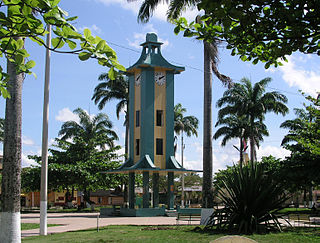
Puerto Maldonado is a city in southeastern Peru in the Amazon rainforest 55 kilometres (34 mi) west of the Bolivian border, located at the confluence of the Tambopata and Madre de Dios rivers. The latter river joins the Madeira River as a tributary of the Amazon. This city is the capital of the Madre de Dios Region.

The Interoceanic Highway or Trans-oceanic highway is an international, transcontinental highway in Peru and Brazil that connects the two countries. It was completed in 2011, and runs east to west, spanning 2,600 kilometres (1,600 mi).
The Amahuaca or Amhuaca are indigenous peoples of the southeastern Amazon Basin in Peru and Brazil. Isolated until the 18th century, they are currently under threat from ecological devastation, disease and violence brought by oil extractors and illegal loggers. In 1998, they numbered about 520. The largest community of the Amahuaca is in Puerto Varadero, a jungle community on the Peruvian–Brazilian border.
Piro is a Maipurean language spoken in Peru. It belongs to the Piro group which also includes Iñapari (†) and Apurinã. The principal variety is Yine. The Manchineri who live in Brazil (Acre) and reportedly also in Bolivia speak what may be a dialect of Yine. A vocabulary labeled Canamaré is "so close to Piro [Yine] as to count as Piro", but has been a cause of confusion with the unrelated Kanamarí language.

La Convención Province is the largest of thirteen provinces in the Cusco Region in the southern highlands of Peru.
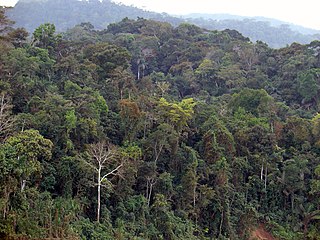
Peruvian Amazonia, informally known locally as the Peruvian jungle or just the jungle, is the area of the Amazon rainforest included within the country of Peru, from east of the Andes to the borders with Ecuador, Colombia, Brazil and Bolivia. This region comprises 60% of the country and is marked by a large degree of biodiversity. Peru has the second-largest portion of the Amazon rainforest after the Brazilian Amazon.

The Amazon rubber cycle, or boom was an important part of the economic and social history of Brazil and Amazonian regions of neighboring countries, being related to the extraction and commercialization of rubber. Centered in the Amazon Basin, the boom resulted in a large expansion of colonization in the area, attracting immigrant workers, generating wealth, causing cultural and social transformations, and disrupting local indigenous societies.
The Mashco-Piro or Mascho Piro, also known as the Cujareño people and Nomole, are an indigenous tribe of nomadic hunter-gatherers who inhabit the remote regions of the Amazon rainforest. They live in Manú National Park in the Madre de Dios Region in Peru. They have in the past actively avoided contact with non-native peoples.
Alto Purús National Park is a national park in the Amazon rainforest of Peru, established in 2004. It covers an area of 2,510,694.41 ha (9,693.85 sq mi) in the provinces of Purús (Ucayali), Tahuamanu and Tambopata.
Las Piedras District is one of four districts of the province Tambopata in Peru. Bordered by the Rio Mavila on the northern boundary and the Rio Las Piedras to the south, the district comprises typical uninhabited lowland neotropical rainforest: Largely moist broadleaf evergreen or semi-evergreen with overstorey canopy and emergent crowns, medium layer canopy, lower canopy, shrub level and understory. The forest-structure is influenced by the flood regimes of the Las Piedras River, a highly meandering, white-water affluent of the Madre de Dios River.

The Tambopata River is a river in southeastern Peru and northwestern Bolivia. Most of the Tambopata is in the Madre de Dios and Puno regions in Peru, but the upper parts of the river forms the border between Peru and Bolivia, and its origin is in La Paz department in Bolivia. The Tambopata is a tributary of the Madre de Dios River, into which it merges at the city of Puerto Maldonado. The river flows through the Tambopata National Reserve.

Carlos Fermín Fitzcarrald López was a Peruvian rubber baron. He was born in San Luis, Ancash. In the early 1890s he discovered the Isthmus of Fitzcarrald, which was a portage route that allowed transportation from the Ucayali River into the Madre de Dios River basin. He drowned in a river accident on the Urubamba River in 1897.
The Yine are an indigenous people in Peru. In the Cusco, Loreto, and Ucayali Departments, they live along the Urubamba River. They live along the Madre de Dios River in the Madre de Dios Department.

The Fitzcarrald Isthmus is an 11 km long land bridge that connected important rubber trade routes of the Urubamba River and the Madre de Dios River in Peru.

Carlos Scharff was a Peruvian rubber baron of German descent who was active along the Upper Purus and Las Piedras rivers during the Amazon rubber boom in Peru. He also served for many years during his youth as an agent for the Belgian consulate in Brazil.



